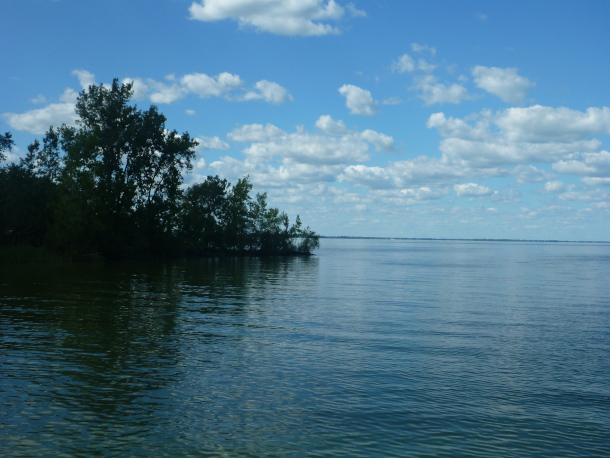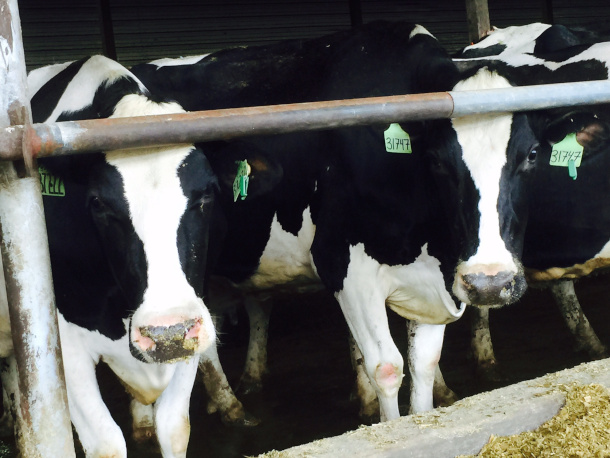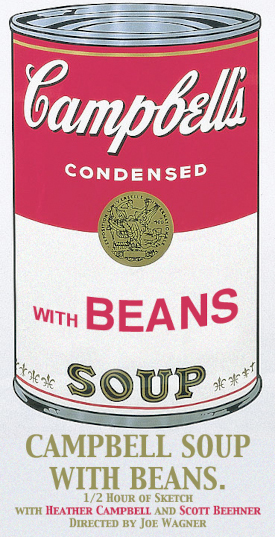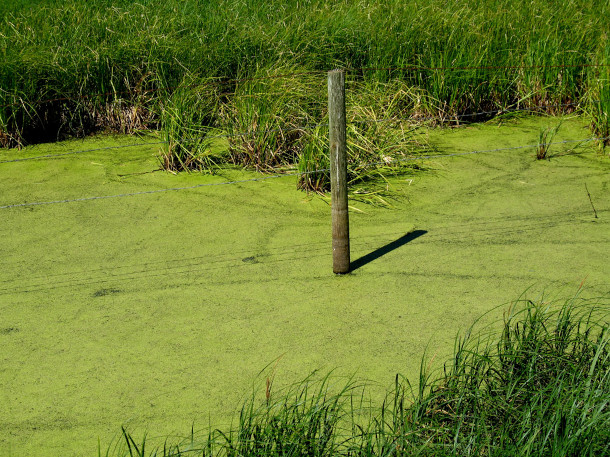Lake Erie Sickly Green
Air Date: Week of April 26, 2024

Lake Erie provides drinking water for about 11 million people. (Photo: Jackie, Flickr, CC BY 2.0)
Lake Erie is being sickened by agricultural runoff and polluted wastewater, turning this important source of freshwater green. The US Department of Justice and two environmental groups recently filed suit against the Campbell Soup Company for its alleged contribution to the problems. Lake Erie Waterkeeper Sandy Bihn joins Host Aynsley O’Neill to explain the toll that multiple sources of pollution are taking on the lake.
Transcript
O’NEILL: Lake Erie has been at the forefront of a national water pollution crisis for decades. And in March, the United States Department of Justice and a couple of environmental groups filed two lawsuits against the Campbell Soup Company. They allege that the company’s manufacturing plant in Napoleon, Ohio has allowed polluted wastewater to flow into the Maumee River and then into Lake Erie. This pollution is on top of a more widespread problem of runoff from nearby agriculture and livestock operations. The resulting bacteria found in the lake include E. coli, linked to human health concerns like diarrheal diseases. And the phosphorus-rich wastewater also feeds algal blooms that turn the water green – and we don’t mean eco-friendly. For more, we turn now to Lake Erie Waterkeeper Sandy Bihn. Sandy, welcome to Living on Earth!
BINH: Thank you. Thank you for having me here.
O'NEILL: For those of us who haven't been to the Great Lakes region, tell us about Lake Erie and why a clean Lake Erie is so important.
BINH: Well, the Great Lakes are an amazing surface body of water, they provide drinking water for 40 million people. And Lake Erie itself provides drinking water for 11 million people. So it's one of the five Great Lakes and the greatest freshwater source in the world. And so--and Lake Erie is the southernmost of the Great Lakes. The shallowest, the warmest, and it has three basins. And here in the western basin, it is the most vulnerable, so it gets sick easier because it's shallow and warm, but can also heal quicker, because it turns over so much.
O'NEILL: And as I understand it, at one point, Lake Erie was considered sort of a textbook example of the Clean Water Act at work.
BINH: Absolutely. We were the comeback lake, right? The body of water. We were the example throughout the world. So in the 50s and 60s, the Clean Water Act happened and they took the toxics out of the waters through the Clean Water Act. And also along with that, that's not often talked about, is the algae that was in Lake Erie that was so putrid and awful. They took phosphorus out of laundry detergent, and 28 states passed a ban to have the phosphorus out of the detergent. And not long after that happened, Lake Erie was once again blue and healthy and thrived, and the walleye came back, the wall--it's now the walleye fishing capital of the world. And then in the 90s, all of a sudden she started--not started, she almost instantly turned green again. And that happened when the practice of confining animals in small spaces in barns, in this case dairy cows, came to our area, and the liquid manure was applied, and almost instantly the lake turned green. And there's not much being done to manage that manure, because it's agriculture. And the laws for human waste are in place and require human waste to be treated. But you know, traditionally, animals were pastured, and they were spread over millions of acres, their manure was, and it wasn't a problem. But now that they're confining them, if you look at what we call NOAA MODIS maps right now, you would see a very turbid green lake very early in the season.

Manure from confined animal feeding operations (CAFOs) has also contributed high amounts of phosphorus to Lake Erie. (Photo: MPCA, Flickr, CC BY-NC 2.0)
O'NEILL: And now the Campbell's Soup Company is being sued for violating the Clean Water Act. What's going on there?
BINH: It's a sad story, actually. So when you put too much phosphorus in the water, it creates harmful algae that creates microsystem and toxins that have health consequences, and obviously are problems for the water and swimming and all that. The difference between manure being applied in a CAFO, or in a confined animal feeding operation, is it's spread over the land. And especially for cow and pig manure. It's liquid. You know, it doesn't take a rocket scientist to know that when you apply liquid on a field, it's going to go to the drains and it's going to come into the waterways, the streams and the lake. But other waste comes to waterways through a pipe, known as point sources. And Campbell's is one of those. It's a point source. It's a processing plant for their soups and other products. And so that water comes into the Maumee river and into Lake Erie. Sadly, they have an excess phosphorus discharge that comes into the Maumee. And they also have 400 acres of a field where they spread their wastewater, which has excess phosphorus coming into the lake. And it's helping to turn Lake Erie green. They've had violations for over five years, maybe over 10 or more. And the state of Ohio nor the federal government has called them out. Although now, Environment America, Lake Erie Waterkeeper and the U.S. Department of Justice have taken it to court and are requiring something to be done. Ohio EPA remains silent on this, which is really sad.
O'NEILL: And so what has been Campbell's response to the concerns after they've been raised by environmental groups?
BINH: They're saying they'll fix it. And they'll take care of it. So that's happening now. And there's negotiations to settle it. And there's also a component of that, that the economic benefit that they've derived from putting too much in the lake instead of treating it, which has a cost to it, that they'll have to do a project or something that will mitigate that--what they've done for past years, and that's just being discussed now and there's not much more detail I can give you.

Campbell’s Soup is being sued for allegedly violating the Clean Water Act. The complaints say excess phosphorus in the company’s wastewater is polluting Lake Erie. (Photo: Heather Anne Campbell, Flickr, CC BY-NC-ND)
O'NEILL: Okay, so let's talk now about solutions. What is being proposed that can help mitigate some of this harm and hopefully return Lake Erie to a cleaner state, whether that be in response to the liquid manure spreading or in response to Campbell?
BINH: Well, they're two separate issues. Campbell has a pipe that they can treat it and they can clearly stop very soon if they simply put in the equipment that's needed. And they can stop the excess phosphorus and other pollutants from going in the lake, that's easy to do. But the manure problem, the liquid manure and solid manure from the confined animal feeding operations, the big ones, it can be done. It just takes the political will to do it. And meat and dairy is the most powerful lobbying group in the U.S.—right up at the top in terms of a lot of money. And so right now in this watershed we have an estimated 400,000 dairy cows, 1.8 million hogs, 24 million chickens, almost all of that being in these confined animal feeding operations being applied close to the barns, and the federal government, USDA allows two to four times more phosphorus to be put on the ground in the manure than is needed by the crops. So it doesn't take a rocket scientist to know that doesn't compute. But meat and dairy, this is their profit margin, right? This is how they make more money, is to pass along and put that manure the cheapest way, which is on the fields untreated. And so that's wrong, any more than a failing septic system shouldn't be allowed, any more than a sewer plant shouldn't be allowed to overflow. Why are they allowed to put excess manure on the fields, far more than they need?
O'NEILL: It seems to me that as things stand currently, lakeside communities, waterfront communities might feel like they're being asked to make a choice between clean water and manufacturing or agriculture, you know, a healthy environment or a healthy economy. What do you make of that?

Excess phosphorus can cause harmful algal blooms and pollute drinking water. (Photo: tuchodi, Flickr, CC BY-SA 2.0)
BINH: I think that's a big myth. You know, just because when the Clean Water Act was passed, industries found a way not to put all those chemicals, not to put the metals in the water. And they internalize those costs. We have clean water, those businesses are there today. I mean, a great example is Procter & Gamble. They made the same argument you're making now for manure, for phosphorus and laundry detergent. You know, you're going to put us out of business. It's not going to work. And I've got quotes from them in studying the history of this. And you know what, we still have Tide today. And we have clean water. So they need to internalize their costs. But the problem is, it shouldn't be borne by the local farmer. It should be borne by the Tysons, the Cargills, the Smithfields and all the big people that can afford to internalize that cost and make it right. They shouldn't be lobbying to continue to pollute the ground, when in fact they could solve the problem and find the technology and what's needed not to have this happen.
O'NEILL: Sandy Binh has been Lake Erie Waterkeeper since 2004. Sandy, thank you so much for taking the time with me today.
BINH: Thank you.
O’NEILL: We reached out to the Campbell Soup Company for a response that reads in part:
“We have taken a number of steps to improve our existing wastewater management operations and will continue to take immediate action to address this issue.”
We’ll post the full statement on the Living on Earth website, loe.org. We also contacted the Ohio Dairy Producers Association for comment but did not hear back in time for broadcast.
Full Campbell Soup Company Statement: "We have taken a number of steps to improve our existing wastewater management operations and will continue to take immediate action to address this issue. We have retained independent experts to help implement short-term improvements and have capital investments planned to resolve this issue permanently. We take this matter seriously and will continue to work with regulators and other stakeholders to improve our operations and comply with all environmental regulations."
Links
The lawsuit filed against Campbell Soup
Reuters | “Campbell Soup Sued Over E. coli, Phosphorous Discharges at Ohio Plant”
Environmental Law and Policy Center |“Ohio Campbell’s Soup Facility is M’m M’m Bad”
Living on Earth wants to hear from you!
Living on Earth
62 Calef Highway, Suite 212
Lee, NH 03861
Telephone: 617-287-4121
E-mail: comments@loe.org
Newsletter [Click here]
Donate to Living on Earth!
Living on Earth is an independent media program and relies entirely on contributions from listeners and institutions supporting public service. Please donate now to preserve an independent environmental voice.
NewsletterLiving on Earth offers a weekly delivery of the show's rundown to your mailbox. Sign up for our newsletter today!
 Sailors For The Sea: Be the change you want to sea.
Sailors For The Sea: Be the change you want to sea.
 The Grantham Foundation for the Protection of the Environment: Committed to protecting and improving the health of the global environment.
The Grantham Foundation for the Protection of the Environment: Committed to protecting and improving the health of the global environment.
 Contribute to Living on Earth and receive, as our gift to you, an archival print of one of Mark Seth Lender's extraordinary wildlife photographs. Follow the link to see Mark's current collection of photographs.
Contribute to Living on Earth and receive, as our gift to you, an archival print of one of Mark Seth Lender's extraordinary wildlife photographs. Follow the link to see Mark's current collection of photographs.
 Buy a signed copy of Mark Seth Lender's book Smeagull the Seagull & support Living on Earth
Buy a signed copy of Mark Seth Lender's book Smeagull the Seagull & support Living on Earth

